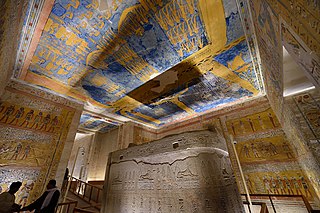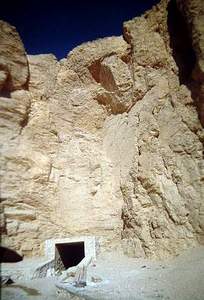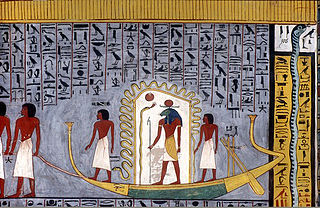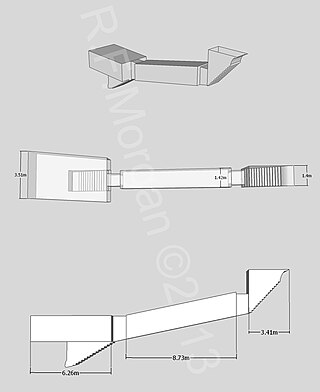
Tomb KV5 is a subterranean, rock-cut tomb in the Valley of the Kings. It belonged to the sons of Ramesses II. Though KV5 was partially excavated as early as 1825, its true extent was discovered in 1995 by Kent R. Weeks and his exploration team. The tomb is now known to be the largest in the Valley of the Kings. Weeks' discovery is widely considered the most dramatic in the valley since the discovery of the tomb of Tutankhamun in 1922.

Tomb KV6 in Egypt's Valley of the Kings is the final resting place of the 20th-Dynasty Pharaoh Ramesses IX. However, the archaeological evidence and the quality of decoration it contains indicates that the tomb was not finished in time for Ramesses's death but was hastily rushed through to completion, many corners being cut, following his demise.

Neferkare Setepenre Ramesses IX was the eighth pharaoh of the Twentieth Dynasty of Egypt. He was the third longest serving king of this Dynasty after Ramesses III and Ramesses XI. He is now believed to have assumed the throne on I Akhet day 21 based on evidence presented by Jürgen von Beckerath in a 1984 GM article. According to Papyrus Turin 1932+1939, Ramesses IX enjoyed a reign of 18 years and 4 months and died in his 19th Year in the first month of Peret between day 17 and 27. His throne name, Neferkare Setepenre, means "Beautiful Is The Soul of Re, Chosen of Re." Ramesses IX is believed to be the son of Mentuherkhepeshef, a son of Ramesses III, since Mentuherkhopshef's wife, the lady Takhat bears the prominent title of King's Mother on the walls of tomb KV10, which she usurped and reused in the late 20th Dynasty; no other 20th Dynasty king is known to have had a mother with this name. Ramesses IX was, therefore, probably a grandson of Ramesses III.

Usermaatre Akhenamun Ramesses VIII or Ramesses Sethherkhepshef Meryamun, was the seventh Pharaoh of the Twentieth Dynasty of the New Kingdom of Egypt, and was the 9th of the 10 sons of Ramesses III.

Twosret, also spelled Tawosret or Tausret was the last known ruler and the final pharaoh of the Nineteenth Dynasty of Egypt.

Tomb KV9 in Egypt's Valley of the Kings was originally constructed by Pharaoh Ramesses V. He was interred here, but his uncle, Ramesses VI, later reused the tomb as his own. The layout is typical of the 20th Dynasty – the Ramesside period – and is much simpler than that of Ramesses III's tomb (KV11). The workmen accidentally broke into KV12 as they dug one of the corridors. In 2020, the Egyptian Tourism Authority released a full 3D model of the tomb with detailed photography, available online.

Tomb KV19, located in a side branch of Egypt's Valley of the Kings, was intended as the burial place of Prince Ramesses Sethherkhepshef, better known as Pharaoh Ramesses VIII, but was later used for the burial of Prince Mentuherkhepshef instead, the son of Ramesses IX, who predeceased his father. Though incomplete and used "as is," the decoration is considered to be of the highest quality.

Tomb KV2, found in the Valley of the Kings, is the tomb of Ramesses IV, and is located low in the main valley, between KV7 and KV1. It has been open since antiquity and contains a large amount of graffiti.

Tomb KV7 was the final resting place of ancient Egyptian Pharaoh Ramesses II of the Nineteenth Dynasty.

Tomb KV11 is the tomb of ancient Egyptian Ramesses III. Located in the main valley of the Valley of the Kings, the tomb was originally started by Setnakhte, but abandoned when it unintentionally broke into the earlier tomb of Amenmesse (KV10). Setnakhte was buried in KV14. The tomb KV11 was later restarted and extended and on a different axis for Ramesses III.

Tomb KV1, located in the Valley of the Kings in Egypt, was used for the burial of Pharaoh Ramesses VII of the Twentieth Dynasty. Although it has been open since antiquity, it was only properly investigated and cleared by Edwin Brock in 1984 and 1985. The single corridor tomb is located in Luxor's West Bank, and is small in comparison to other tombs of the Twentieth Dynasty.

Tomb KV3, located in Egypt's Valley of the Kings, was intended for the burial of an unidentified son of Pharaoh Ramesses III during the early part of the Twentieth Dynasty. It is similar in design to the "straight axis" tombs typical of this dynasty, and an ostracon written in hieratic script from the time of Ramesses III mentions the founding of a tomb for a royal prince, likely this tomb. The unfinished state of a couple of rooms in the tomb along with scant archeological evidence suggests that the tomb was never used. Some have suggested that it was originally intended for use by the prince regent who would succeed as Ramesses IV, and who started building his own tomb (KV2) soon after he came to the throne.

Tomb KV18, located in the Valley of the Kings in Egypt, was intended for the burial of Pharaoh Ramesses X of the Twentieth Dynasty; however, because it was apparently abandoned while still incomplete and since no funerary equipment was ever found there, it is uncertain whether it was actually used for his burial.

Tomb KV16 is located in the Valley of the Kings in Egypt. It was used for the burial of Pharaoh Ramesses I of the Nineteenth Dynasty. The burial place was discovered by Giovanni Belzoni in October 1817.

Tomb KV47, located in the Valley of the Kings in Egypt, was used for the burial of Pharaoh Siptah of the Nineteenth Dynasty. It was discovered on December 18, 1905 by Edward R. Ayrton, excavating on behalf of Theodore M. Davis; Siptah's mummy had been found earlier, cached in KV35. It was the last of the Nineteenth and Twentieth Dynasty kings tombs to be uncovered in the Valley. Ayrton stopped his excavation in 1907 due to safety fears, and Harry Burton returned in 1912 to dig further. The cutting of a side passage was halted after the workmen cut into Side Chamber Ja of the tomb of Tia'a (KV32). The tomb was unfinished at the time of its use.

Tomb KV49, located in the Valley of the Kings, in Egypt is a typical Eighteenth Dynasty corridor tomb. It was the first of a series of tombs discovered in 1906 by Edward R. Ayrton in the course of his excavations on behalf of Theodore M. Davis. The tomb was abandoned before it was completed, and the work was halted as the stairwell in the single chamber was being cut. It was probably used as a store for royal linen, or was used as a mummy-restoration area in the later New Kingdom.

Tomb KV50 is located in the Valley of the Kings, in Egypt. It was discovered in 1906 by Edward R. Ayrton excavating on behalf of Theodore M. Davis. Together with KV51 and KV52, it forms a group known as the "Animal Tombs". It contained the burial of a dog mummy and a mummified monkey and is probably associated with the nearby tomb of Amenhotep II (KV35).

Tomb KV52 is located in the Valley of the Kings, in Egypt. It was discovered in 1906 by Edward R. Ayrton excavating on behalf of Theodore M. Davis. Together with KV50 and KV51 it forms a group known as the "Animal Tombs", it contained a mummified monkey, and is probably associated with the nearby tomb of Amenhotep II (KV35).

Tomb KV53 is located in the Valley of the Kings, in Egypt. It was discovered in 1906 by Edward R. Ayrton excavating on behalf of Theodore M. Davis. It has been excavated but never been fully planned, and consists of a single chamber at the end of a shaft.

The Valley of the Kings, also known as the Valley of the Gates of the Kings, is a valley in Egypt where, for a period of nearly 500 years from the 16th to 11th century BC, rock-cut tombs were excavated for the pharaohs and powerful nobles of the New Kingdom.





















